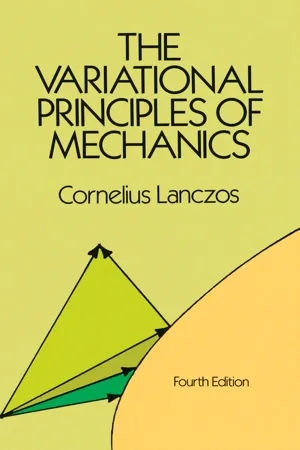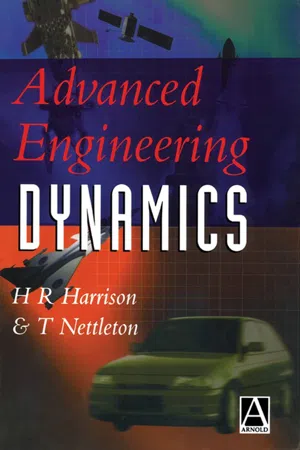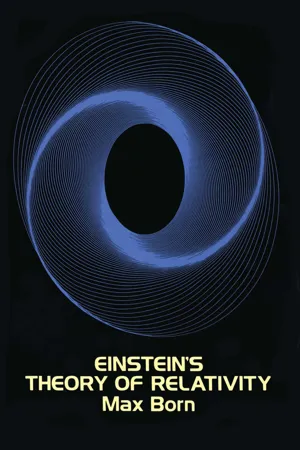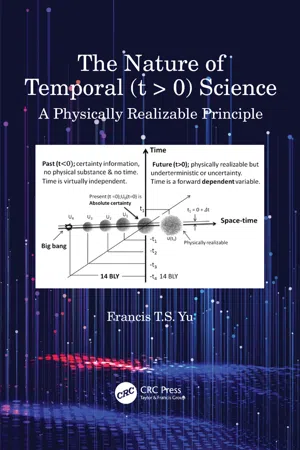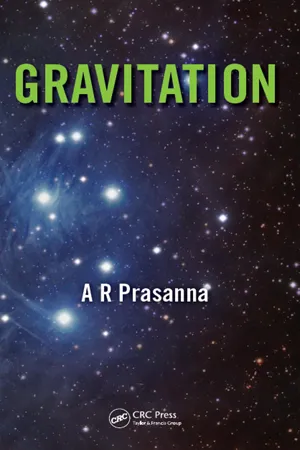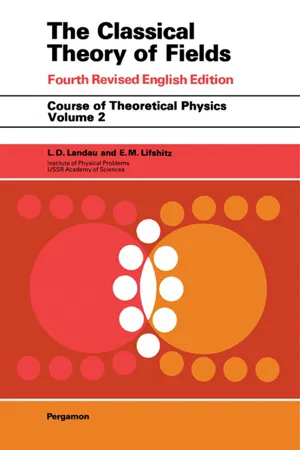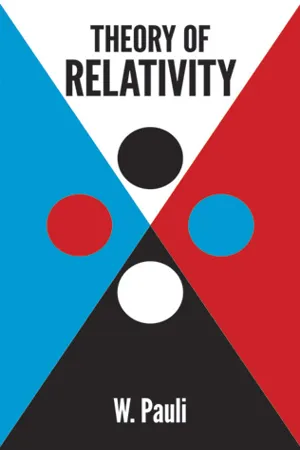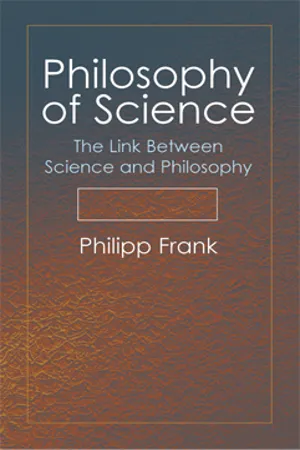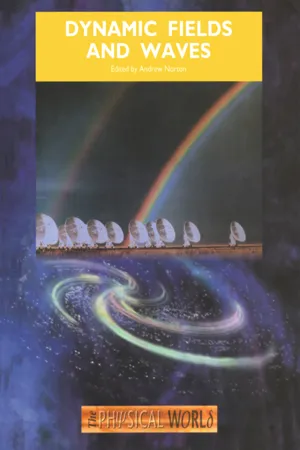Physics
Relativistic Kinematics
Relativistic kinematics is a branch of physics that deals with the motion of objects at speeds close to the speed of light. It involves the application of Einstein's theory of special relativity to describe how time, length, and mass change for objects in motion. Relativistic kinematics provides a framework for understanding the behavior of particles at high velocities.
Written by Perlego with AI-assistance
Related key terms
11 Key excerpts on "Relativistic Kinematics"
- eBook - ePub
- Cornelius Lanczos(Author)
- 2012(Publication Date)
- Dover Publications(Publisher)
General relativity cannot be properly treated without the field concept, which belongs to the realm of the mechanics of continua. Our following exposition is thus restricted to the kinematics and dynamics of Special Relativity. However, the dynamical law of General Relativity falls within the scope of Lagrangian and Hamiltonian dynamics and will be included in our discussions.2. Relativistic Kinematics. In his fundamental paper Einstein1 introduced the following two postulates:(a) All reference systems that move relative to each other with constant velocity are equally legitimate for the description of nature, without any preference for any particular one of them.(b) The velocity of light c is the same universal constant, measured in any of these systems.The second postulate leads to the following apparent absurdity. Consider an observer B moving relative to A with the velocity of light c. He emits a light signal in the direction of his own motion which moves relative to him with the velocity c. According to our common notions the velocity of this signal relative to A should be 2c, while the second postulate of relativity demands that it is c. Hence c = 2c, which is self-contradictory. This is no longer so, however, if we give up the intuitive notion of a time t which is the same for both observers A and B.According to Einstein we should not prejudice in advance the transformation equations which exist between the coordinates of the system A and those of the system B. Assuming that the motion of B relative to A occurs in the X-direction, we putwhere a, β, γ, δ are constants, since we do not want to lose the linearity of the transformation. But by abandoning the equation t = t′ (which corresponds to the choice γ = 0, δ = 1) we have gained the freedom of two additional constants.All formulae of special relativity gain greatly in simplicity, if we agree to measure the time in such units that the velocity of light becomes unity (this means that the usual time t is replaced by t/c). If we want to return to the formulae involving our ordinary time t, we have merely to change all t to ct and all v to v/c. We shall frequently make use of this simplification and thus agree that the invariant velocity of light has the numerical value c = - eBook - ePub
- H. Harrison, T. Nettleton(Authors)
- 1997(Publication Date)
- Butterworth-Heinemann(Publisher)
9Relativity
9.1 Introduction
In this chapter we shall reappraise the foundations of mechanics taking into account Einstein’s special theory of relativity. Although it does not measurably affect the vast majority of problems encountered in engineering, it does define the boundaries of Newtonian dynamics. Confidence in the classical form will be enhanced as we shall be able to quantify the small errors introduced by using Newtonian theory in common engineering situations.The laser velocity transducer employs the Doppler effect which, for light, requires an understanding of special relativity. The form of the equations derived for cases where the velocities of the transmitter and/or the receiver are small compared with that of the signal is the same for both sound and light. This will be discussed later.We shall also consider the definition of force. It is of note that relativistic definitions are such that they encompass the Newtonian. The general theory of relativity raises some interesting questions regarding the nature of force, but these do not materially affect the equations of motion already derived.9.2 The foundations of the special theory of relativity
It is not our intention to retrace the steps leading to the theory other than to mention the most significant milestones. In the same way that Isaac Newton crystallized the laws of mechanics which have formed the basis for the previous chapters in this book, Albert Einstein provided the genius that solved the riddle of the constancy of the speed of light.James Clerk Maxwell’s equations for electrodynamics predicted that all electromagnetic waves travelled at a constant speed in a vacuum. If the value of the speed of light, c - eBook - ePub
- A.P. French(Author)
- 2017(Publication Date)
- CRC Press(Publisher)
5Relativistic KinematicsThe velocity of light forms the upper limit of velocities for all material bodies .. . The simple mechanical law of adding and subtracting velocities is no longer valid or, more precisely, is only approximately valid for small velocities, but not for those near the velocity of light. The number expressing the velocity of light appears explicitly in the Lorentz transformation, and plays the role of a limiting case, like the infinite velocity in classical mechanics.A. EINSTEIN AND L. INFELD ,The Evolution of Physics (1938)Transformation of Velocities
ONCE WE HAVE the Lorentz transformations for distance and time, it is a straightforward matter to consider the time derivatives of displacements as measured in two different inertial frames. Although we are in general concerned with motion in three-dimensional space, most of the results of interest can be developed in terms of motion in two dimensions. That is because (as we pointed out in Chapter 3 ) there is only one uniquely defined direction involved—the direction of relative motion of the inertial frames. This is an axis of symmetry, and any displacement can be analyzed into components along and transverse to it. Logically one should, perhaps, embody a reminder of this fact in the equations by using cylindrical coordinates, in which a vector is characterized by its component along the symmetry axis, its component transverse to this axis, and one angle—the azimuth—which is the angle between some fixed plane through the axis and the plane defined by the axis and the vector. In many instances the azimuth angle would then not appear in the results. Tradition has, however, enshrined the practice of using Cartesian coordinates, with y and z axes perpendicular to each other and to the direction (x ) of relative motion of the reference frames. We shall therefore continue, as we have begun, with an acceptance of this coordinate representation. But the transformations appropriate to the x and y directions really tell the whole story and the transformations for the z direction can be constructed, usually by inspection, from those for the y direction. Therefore, unless there is special reason to do otherwise, we shall treat vectors as though they have x and y - eBook - ePub
- Max Born(Author)
- 2012(Publication Date)
- Dover Publications(Publisher)
From this formula we read off our statement, because under the conditions mentioned above, the second term of the right-hand side is always smaller than 1 (the denominator is larger than 1 and both factors in the numerator are smaller than 1). The corresponding result holds, of course, for transverse motion, and, indeed, for motion in any direction.Hence the velocity of light is, kinematically, a limiting velocity which cannot be exceeded. This assertion of Einstein's theory has encountered much opposition. It seemed an unjustifiable limitation for future discoverers who were prepared to find motions occurring with velocities greater than that of light.We know that the β-rays of radioactive substances are electrons moving nearly with the velocity of light. Why should it not be possible to accelerate them so that they move with a velocity exceeding that of light?Einstein's theory, however, asserts that in principle this is not possible, because the inertial resistance or the mass of a body increases with the velocity approaching that of light. We thus arrive at a new system of dynamics which is built upon Einstein's kinematics.7. Einstein's DynamicsThe mechanics of Galileo and Newton is intimately connected with the old kinematics. The classical principle of relativity, in particular, depends on the fact that changes of velocity–accelera-tions–are invariant with respect to Galileo transformations.Now we cannot take one kinematics for one part of physical phenomena and another kinematics for another part, holding to invariance with respect to Galileo transformations for mechanics and invariance with respect to Lorentz transformations for electrodynamics.We know, however, that the former transformations are a limiting case of the latter, namely, those for which the constant c is infinite. Accordingly, following Einstein, we shall assume that classical mechanics is not strictly valid but rather requires some kind of modification. The laws of the new mechanics must be invariant with respect to Lorentz transformations.In order to find these laws we must decide which fundamental laws of classical mechanics are to be retained and which rejected or modified. The fundamental law of dynamics with which we started is the law of momentum. We defined momentum on p. 34 - eBook - ePub
The Nature of Temporal (t > 0) Science
A Physically Realizable Principle
- Francis T.S. Yu(Author)
- 2022(Publication Date)
- CRC Press(Publisher)
r is a relativistic distance that had been expended between an assumed light beam started at position S and a particle simultaneously started at position 1 moving at a constant velocity of v, from which we see that the moving particle and the light beam reached simultaneously at position 2. By this the light beam had traveled an extra distance of d = (c – v) Δt′ more (or relative) than the particle had had traveled. Thus, we see that Einstein's special theory is relativistic to distance within our temporal (t > 0) subspace, instead of relative to time since we cannot change time. This means that a particle and the light beam simultaneously arrived at position 2 at the same time of the temporal (t > 0) subspace, which is the time of every subspace within our universe that includes position 1, 2, and S. Once again, we have shown that there is no time-gain or time-loss of a traveling particle regardless of its speed.Nevertheless, one of the misleading interpretations of Einstein's special theory must be directional independent. Although the special theory shows a velocity component in it (i.e., v2 ), we had treated a special theory as a directionally independent principle. Yet, within the equation it has a quadratic form of velocity [i.e., (v/c)2 ] which had misled us over a century since Einstein disclosed the theory in 1905 [3]. Yet, when the velocity of the moving particle approaches the speed of light (i.e., v → c), we have a relative distance dr → 0. This is by no means that time is running behind or ahead of the pace of time. But it is the speed of light that travels with time, and it is not the speed of light that changes the pace of time.Similarly, relativistic distance can also be shown in terms of relative velocity of two moving particles. For example, two particles are moving in the same direction but at different speeds (e.g., v1 and v2 ). Aside, Einstein's special theory is not a physically realizable theory within our temporal (t > 0) universe, and it is also incorrectly interpreted as directional-independent, as can be seen from Eq. (5.3) - eBook - ePub
- A R Prasanna(Author)
- 2016(Publication Date)
- CRC Press(Publisher)
Mathematics deals exclusively with the relations of concepts to each other without considerations of their relation to experience. Physics too deals with mathematical concepts; however, these concepts attain physical content only by their clear determination of their relation to the objects of experience. This in particular is the case for concepts of motion, space, and time. The theory of relativity is that physical theory which is based on a consistent physical interpretation of these three concepts. The name is connected with the fact that motion from the point of view of possible experience always appears as the relative motion of one object with respect to another. Motion is never observable as ‘motion with respect to space’ or, as it has been expressed as ‘absolute motion’. The principle of relativity in its widest sense is contained in the statement: ‘The totality of physical phenomena is of such a character that it gives no basis for the introduction of the concept of, absolute motion’.3.2 Postulates and kinematicsEinstein’s famous paper of 1905 [14 ], ‘On the Electrodynamics of Moving Bodies’ starts thus:It is known that Maxwell‘s electrodynamics, when applied to moving bodies, leads to asymmetries which do not appear to be inherent in the phenomena. For example in the case of the reciprocal electrodynamic action of a magnet and a conductor, the observable depends only on the relative motion of the conductor and the magnet. Examples of this sort, together with the unsuccessful attempts to discover any motion of the earth relative to the ‘light medium’, suggest that the phenomena of electrodynamics as well as of mechanics possess no properties corresponding to the idea of absolute rest; rather the same laws of electrodynamics and optics will be valid for all frames of reference for which the equations of mechanics hold good. We will raise this conjecture (hereafter be called the ‘Principle of relativity’) to the status of a postulate.Physics deals with observations of events which occur in space (location) at a given time. Thus one requires four numbers to identify an event. While dealing with Newtonian physics, since ‘time’ was absolute, it was considered to be the same for all observers and thus one could do with the three– dimensional Euclidean manifold for describing the physical laws associated with ‘events’ in space and time. - eBook - ePub
- L D Landau(Author)
- 2013(Publication Date)
- Pergamon(Publisher)
c, and its numerical value isc = 2.998 ×(1.1)10 10cm / sec .(1.1)The large value of this velocity explains the fact that in practice classical mechanics appears to be sufficiently accurate in most cases. The velocities with which we have occasion to deal are usually so small compared with the velocity of light that the assumption that the latter is infinite does not materially affect the accuracy of the results.The combination of the principle of relativity with the finiteness of the velocity of propagation of interactions is called the principle of relativity of Einstein (it was formulated by Einstein in 1905) in contrast to the principle of relativity of Galileo, which was based on an infinite velocity of propagation of interactions.The-mechanics based on the Einsteinian principle of relativity (we shall usually refer to it simply as the principle of relativity) is called relativistic. In the limiting case when the velocities of the moving bodies are small compared with the velocity of light we can neglect the effect on the motion of the finiteness of the velocity of propagation. Then relativistic mechanics goes over into the usual mechanics, based on the assumption of instantaneous propagation of interactions; this mechanics is called Newtonian or classical. The limiting transition from relativistic to classical mechanics can be produced formally by the transition to the limit c → ∞ in the formulas of relativistic mechanics.In classical mechanics distance is already relative, i.e. the spatial relations between different events depend on the system of reference in which they are described. The statement that two nonsimultaneous events occur at one and the same point in space or, in general, at a definite distance from each other, acquires a meaning only when we indicate the system of reference which is used. - eBook - ePub
Scientific Thought
A Philosophical Analysis of some of its fundamental concepts
- C.D. Broad(Author)
- 2014(Publication Date)
- Routledge(Publisher)
I must confess that I have not seen a satisfactory account of this point in any work on the subject. It seems commonly to be assumed that the logical order has been the same as the historical, and that the successive kinematic concepts have represented a steady development of the doctrine that motion is purely relative. Yet some of the chief exponents of the General Theory of Relativity, which is the latest phase of kinematics, use language which seems to imply a thoroughly Absolute Theory. We hear of “kinks” in Space or in Space-Time, and we are told that they modify the motions of matter, or that matter consists of such “kinks.” All this is extremely puzzling after one has been led to believe by the same writers that the General Theory of Relativity is the final triumph of the Relational Theory of Motion. I think we shall find that the logical connexions are not so simple as we have been told; and it will certainly be useful to do our best to throw some light on this dim spot. We cannot, however, profitably discuss this question until we have seen what precisely the various theories assert. The Absolute and Relational Theories of Motion. In the last two chapters we have been discussing the traditional concepts of Space and Time. Now the kinematic concept which strictly corresponds to these is that of Absolute Motion. In accordance with the traditional concepts of Space, Time, and Matter, the three are largely independent entities. The traditional view does not as a rule go very deeply into the question of their mutual relations, but I think the following would be a fair statement of what it tacitly assumes on this subject: Time could have existed without Space or Matter; Space could not have existed without Time, but it could have existed without Matter; Matter could not have existed without both Space and Time. Space needs Time in order to endure, but the only connexion is that all points of Space endure unchanged for ever - eBook - ePub
- W. Pauli(Author)
- 2013(Publication Date)
- Dover Publications(Publisher)
PART I. THE FOUNDATIONS OF THE SPECIAL THEORY OF RELATIVITY1. Historical background (Lorentz, Poincaré, Einstein)The transformation in physical concepts which was brought about by the theory of relativity, had been in preparation for a long time. As long ago as 1887, in a paper still written from the point of view of the elastic-solid theory of light, Voigt1 mentioned that it was mathematically convenient to introduce a local time t' into a moving reference system. The origin of t' was taken to be a linear function of the space coordinates, while the time scale was assumed to be unchanged. In this way the wave equationcould be made to remain valid in the moving reference system, too. These remarks, however, remained completely unnoticed, and a similar transformation was not again suggested until 1892 and 1895, when H. A. Lorentz2 published his fundamental papers on the subject. Essentially physical results were now obtained, in addition to the purely formal recognition that it was mathematically convenient to introduce a local time t' in a moving coordinate system. It was shown that all experimentally observed effects of first order in υ/c (ratio of the translational velocity of the medium to the velocity of light) could be explained quantitatively by the theory when the motion of the electrons embedded in the aether was taken into account. In particular, the theory gave an explanation for the fact that a common velocity of medium and observer relative to the aether has no influence on the phenomena, as far as quantities of first order are concerned.3However, the negative result of Michelson’s interferometer experiment4 , concerned as it was with an effect of second order in υ/c, created great difficulties for the theory. To remove these, Lorentz5 and, independently, FitzGerald put forward the hypothesis that all bodies change their dimensions when moving with a translational velocity υ. This change of dimension would be governed by a factor κ √[1 − (υ2 /c2 ] in the direction of motion, with κ as the corresponding factor for the transverse direction; κ itself remains undetermined. Lorentz justified this hypothesis by pointing out that the molecular forces might well be changed by the translational motion. He added to this the assumption that the molecules rest in a position of equilibrium and that their interaction is purely electrostatic. It would then follow from the theory that a state of equilibrium exists in the moving system, provided all dimensions in the direction of motion are shortened by a factor √[1 − (υ2 /c2 ], with the transverse dimensions unaltered. It now remained to incorporate this “Lorentz contraction” in the theory, as well as to interpret the other experiments6 which had not succeeded in showing the influence of the earth’s motion on the phenomena in question. There was first of all Larmor who, as early as 1900, set up the formulae now generally known as the Lorentz transformation, and who thus considered a change also in the time scale7 . Lorentz’s review article8 , completed towards the end of 1903, contained several brief allusions which later proved very fruitful. He conjectured that if the idea of a variable electromagnetic mass was extended to all ponderable matter, the theory could account for the fact that the translational motion would produce only the above-mentioned contraction and no other effects, even in the presence of molecular motion. This would also explain the Trouton and Noble experiment. In addition, he raised the important question whether the size of the electrons might be changed by the motion.9 However, in the introduction to his article, Lorentz still maintained the principle that the phenomena depended not only on the relative motion of the bodies, but also on the motion of the aether.9a - eBook - ePub
Philosophy of Science
The Link Between Science and Philosophy
- Philipp Frank(Author)
- 2013(Publication Date)
- Dover Publications(Publisher)
3If you don’t take my words too seriously, I would say this: If we assume that all matter would disappear from the world, then, before relativity, one believed that space and time would continue existing in an empty world. But, according to the theory of relativity, if matter and its motion disappeared there would no longer be any space or time.2. “Relativity” in Newtonian Mechanics
We learned in Chapter 3 that Newton’s laws of motion, which verbally determine acceleration with respect to “absolute space,” can only be used for the prediction of observable facts if they are interpreted as referring to an “inertial system” which is a system of physical bodies. As a first approximation, we can identify this system with the constellations of fixed stars as far as we can regard them as forming a rigid system. Newton had already raised the question of whether we can recognize by mechanical experiment performed in a certain room, whether this room is an inertial system or not, and if so, whether or not it is the only inertial system. If we denote by a in the acceleration with respect to an inertial system (S ), Newton’s laws of motion can be written ma in = f, if m is the mass of a body and f the “simple formula”4 which gives us the Newtonian force. If we disregard for the moment nuclear forces which account for the motion of subatomic particles, the motion of masses of average size is determined, as a matter of fact, by only two types of force, electromagnetic and gravitational. In the first case, if the mass is increased (by adding more pieces of matter) the acceleration a in will decrease according to the formula a in = f/m. With sufficiently increased mass, the acceleration will become infinitely small. This is certainly the case if the force is of the electromagnetic type. If e is the electric charge, and E the electric field strength, we have f = eE and a in = e/m × E. In a given field, the acceleration of an increasing mass relative to the inertial system will decrease toward zero. To the electromagnetic type of force belong all forces of cohesion, among them the forces which are produced if one gives a body a direct push or pull. There is, however, a different type of force. We have known since Galileo that, in the case of freely falling bodies, the acceleration with respect to the earth is independent of the mass. This means that f/m is independent of m or f is proportional to m. If f = mg, it is evident that f/m = g is independent of m. - eBook - ePub
- A Norton(Author)
- 2019(Publication Date)
- CRC Press(Publisher)
Einstein’s special theory is entirely concerned with observations that are made with respect to inertial frames. Indeed, that is why the theory is called the special theory of relativity: it only applies to a special class of frames of reference — the inertial frames. Extending this to consider observations made with respect to non-inertial frames would enter into the realm of the general theory of relativity. Because of the equivalence between the effects of gravity and acceleration, such a theory is also a theory of gravity. A detailed discussion of this is a subject left for other courses. Before leaving the subject of inertial frames, there is one further point that needs clarification. You have seen that an accelerating frame of reference cannot be an inertial frame, but what exactly does the term ‘accelerating’ mean in this context? Surely, when saying that a frame of reference is accelerating this really means that it is accelerating relative to something else. What is that something else? Strange as it may seem, the answer appears to be ‘the rest of the Universe’. There seems to be a link between the extent to which a frame of reference is inertial, and its acceleration relative to the distant stars and galaxies. This peculiar relationship between the accuracy of Newton’s first law and the apparent motion of the large-scale distribution of matter in the Universe is not properly understood, and continues to be one of the mysteries of physics. Question 4.1 A workman in a lift at the top of a skyscraper is idling away his time by pushing a cork to the bottom of a bucket of water with his finger, and watching the cork bob upwards when his finger is removed (Figure 4.10). Suddenly the rope holding the lift breaks and the lift and its occupant fall freely towards the ground. (Assume no resistance of any kind.) Taking advantage of the situation (and being a physicist at heart), the workman repeats his experiment with the cork, water and bucket
Index pages curate the most relevant extracts from our library of academic textbooks. They’ve been created using an in-house natural language model (NLM), each adding context and meaning to key research topics.
